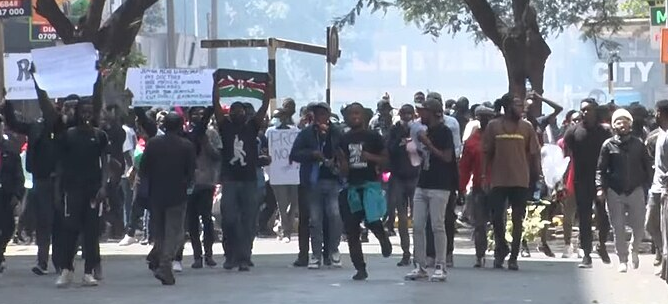I was only seventeen years old, yet I understood at that moment that Dr. King’s death raised the question of whether his philosophy of non-violence and racial integration could ever bring justice to America’s oppressed. Perhaps Malcolm X had been right all along: that white America had to be forced to transform its oppressive racial hierarchy "by any means necessary." Maybe Malcolm X’s famously provocative 1964 formulation, "The Ballot or the Bullet," was the
only realistic way forward.
Although I was a child of the sixties, at that time, I never conceived myself as being part of the countercultural “War Against the Establishment.” White kids in my high school began defying parental authorities and challenged our school’s dress code by putting on frayed Levis and by wearing long hair. That was their business, I thought smugly, not mine. One of the few things we agreed about were the dangers of U.S. military involvement in some far-off Asian country called Vietnam.
But most of the African-American middle class families I knew, friends of my father – a proud veteran of World War II – patriotically believed that Black people had a duty to defend their country. Every Fourth of July when I was growing up, I proudly mounted the American flag on the front door of our home, draped across the entrance. Many other families in our nearly all-Black neighborhood did the same.
By age 15, I had participated in several non-violent civil rights demonstrations in my hometown of Dayton, Ohio. I was elected Youth Chairman of Dayton’s branch chapter of the National Urban League. I also developed close relationships with Jewish teenagers at several local synagogues, and we worked on several cultural and educational projects together.
Looking back over recent American history, there remains a tendency even today for us to frame our understanding of the meaning of “race” in American life within the turbulent contexts of racial anger, racial confrontation and inner-city violence. For the vast majority of African Americans, however, this highly polarized interpretation of how “race” is lived by Blacks is too simplistic. What the vast majority of Negroes wanted throughout the 1950s and early 1960s, and what many were passionately prepared to go to jail for, was the achievement of full and unqualified inclusion into what was widely understood and characterized as “The American Dream.”
The “American Dream” for Black people would require, first, the end to humiliating, discriminatory laws restricting our voting rights, access to public accommodations, hospitals, hotels, restaurants and amusement parks. It would mean the elimination of racially-exclusive hiring policies, especially for professional, managerial and skilled labor employment. The “American Dream” included the full enjoyment of “life, liberty and the pursuit of happiness” as promised by our Declaration of Independence. This was the basic political orientation of Dr. Martin Luther King, Jr., and that of his most prominent lieutenants and followers, within what I now term the “Black Freedom Movement.”
The pursuit of the American Dream all changed fundamentally for me, with the evening of April 4, 1968. I was stunned to learn over the car radio that Dr. King had been assassinated in Memphis, Tennessee, while supporting striking Black sanitation workers fighting for decent wages and benefits. Throughout the nation, thousands of angry Blacks reacted by seizing the streets, burning down commercial stores and white-owned buildings in their ghettoes. The National Guard immediately deployed 75,000 troops to restore order in the blazing inner cities; the U.S. Capitol building was surrounded by armed troops for the
first Black Americans, regardless of class, educational and social backgrounds, were in anguish. The long awaited “Dream Deferred” of Langston Hughes now had become an “American Nightmare.” I flew to Atlanta to cover the funeral of Dr. King for the Black weekly newspaper in my hometown. On the cool, crisp morning of April 9, I arrived at Dr. King’s Ebenezer Baptist Church just as dawn broke;
I was the first person at the church to witness history unfold that day.
Within several hours, anywhere from 40,000 to 100,000 people had crowded around the chapel to pay homage to yet another Black martyr in the cause of civil rights. I walked along with thousands behind the simple, mule-driven wagon that carried King’s body to Morehouse College. I listened with tears streaming down my face as I heard the eloquent eulogy delivered by Dr. Benjamin Mays, one of King’s mentors.
I was only seventeen years old, yet I understood at that moment that Dr. King’s death raised the question of whether his philosophy of non-violence and racial integration could ever bring justice to America’s oppressed. Perhaps Malcolm X had been right all along: that white America had to be forced to transform its oppressive racial hierarchy “by any means necessary.” Maybe Malcolm X’s famously provocative 1964 formulation, “The Ballot or the Bullet,” was the only realistic way forward.
In the thirty-six years since Dr. King’s assassination, millions of African Americans have indeed become part of the American middle class. Several hundred thousand Blacks, in entertainment, sports, and corporate America, have comfortable lives of affluence and wealth. But many millions are still trapped and excluded from even the possibility of a decent life. For them, the “Dream Deferred” has always been an American Nightmare.
Where is the moral and political leadership within Black America to speak to the terrible reality of class division and stratification that cuts across our community? Without that frank and serious discussion, the collapse of the American Dream may bring with it the destruction of the Black community as we know it.
Dr. Marable is Professor of Public Affairs, History and African-American Studies, and the Director of the Center for Contemporary Black History at Columbia University






